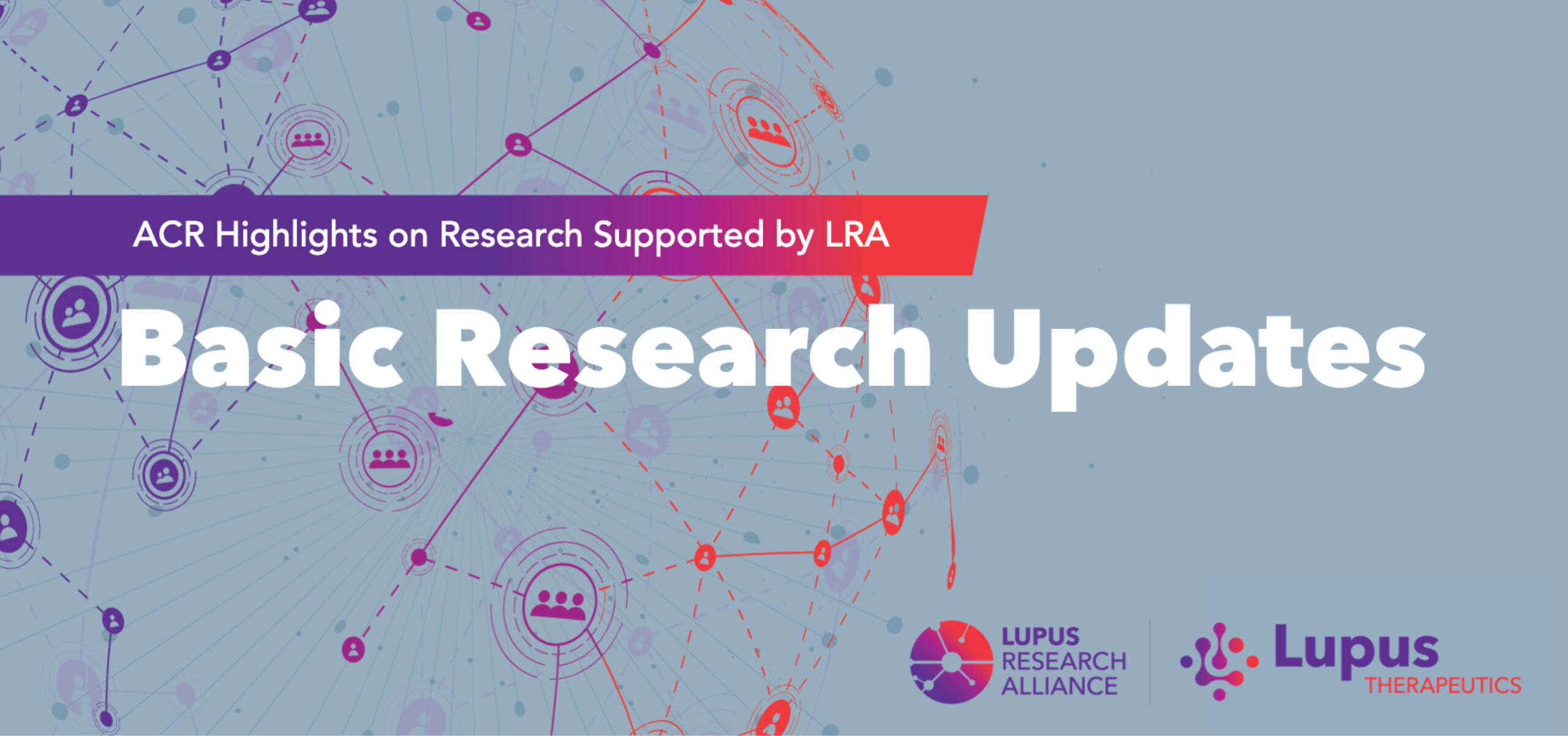LRA-Funded Researchers Presented Cutting Edge Methods and Discoveries at the Annual Rheumatology Meeting

LRA-Funded Researchers Presented Cutting Edge Methods and Discoveries at the Annual Rheumatology Meeting
November, 2022
The Lupus Research Alliance (LRA) aims to support the best science to prevent, treat and cure lupus.
This year during the annual American College of Rheumatology conference, ACR Convergence 2022, which took place from November 10 – 14 in Philadelphia, PA, more than 30 LRA-funded studies were presented by researchers to thousands of rheumatologists from around the world.
LRA is one of several non-profit organizations that partnered with government agencies and industry to transform the current model for developing new diagnostics and treatments through the Accelerating Medicines Partnership (AMP) program. AMP lupus researchers presented during ACR their use of machine learning to improve the diagnosis of lupus, new biomarkers to predict treatment response, and novel approaches to explore immune dysregulation, with the prospect of advancing treatments and improving the quality of life for people living with lupus.
Following are three studies we wanted to highlight that were presented by LRA-funded researchers:
Cellular Immunophenotyping in Lupus with Mass Cytometry
Deepak Rao, MD, PhD, Assistant Professor of Medicine and Co-Director of the Center for Cellular Profiling and Brigham and Women’s Hospital, presented the ACR Edmund L. Dubois, MD, Memorial Lecture. The focus was on how immunophenotyping – an approach used to identify and study immune cells – could be used in clinic to determine if patients’ immune cells are healthy and working properly or whether the immune cells have acquired features that indicate the unhealthy behavior of the immune system.
Dr. Rao said that patients with lupus often inquire about the health status of their immune system. However, providing an accurate response to this question is challenging because the health status of many organs in the body can be measured via specific diagnostic tests, but there is no such test for the immune system.
It is common for patients with early lupus to have symptoms; however, the results of tests are often inconclusive, not clearly indicating an abnormal immune system function. Immunophenotyping immune cells in blood could define a signature that would suggest an abnormal overactive immune system, which is a hallmark of systemic lupus erythematosus (SLE). This signature could be used to identify and diagnose lupus in patients, even in its early stages.
Research from multiple groups has identified four types of cells that are increased in people with SLE: T peripheral helper (Tph) cells, T follicular helper (Tfh) cells, age-associated B cells (ABC), and plasmablasts (PB). Dr. Rao and his team used mass cytometry – a highly advanced technique that is used to immunophenotype immune cells – to develop a lymphocyte activation score, which provides information if the four immune cell types associated with SLE, Tph, Tfh, ABC and PB cells are overactive and unhealthy. To test if this approach could be used in the clinic, Brigham and Women’s Hospital Center for Cellular Profiling is analyzing immune cells from the blood of patients with lupus symptoms, delivering same-day results. Over the next year, Dr. Rao’s team will test for the association between the immune activation score and lupus diagnosis. Results of these studies could guide researchers and clinicians in terms of which cell populations they should focus on to understand lupus pathogenesis better.
Instability of the gut microbiome communities in Patients with Active Lupus Kidney Disease
Gregg Silverman, MD, Professor of Medicine and Pathology at New York University School of Medicine, shared research that provides novel information on how pathobionts, potentially dangerous bacterial microbes living in the gut, and their components, contribute to lupus nephritis.
Dr. Silverman’s research demonstrates that a population of pathobiont bacteria called Ruminococcus gnavus, which are infrequent in healthy people, often expand and undergo “blooms” in the intestines of patients with lupus nephritis flares, contributing to activation of the immune system. The team also isolated and then investigated the genetic makeup of Ruminococcus gnavus strains from these patients during flares and found that these particular bacteria use 40 genes not found in healthy strains, to adapt and thrive in the gut of lupus patients. This helps explain why and how it outcompetes other intestinal bacteria to undergo intestinal “blooms” that may be detrimental to its host. Further, a special component, called a lipoglycan, found only in these lupus strains of Ruminococcus gnavus. When given to healthy mice, these lupus strains result in a “leaky gut” enabling the escape of these microbes from the intestines into surrounding tissues and activation of the immune system, and induces production of ANA autoantibodies, one of the central hallmarks of SLE. These studies suggest that this bacterium could worsen lupus nephritis and cause the disease to progress.
Dr. Silverman’s team also presented research demonstrating that intestinal Ruminococcus gnavus blooms, in lupus patients with disease flares causes systemic platelet activation. Platelets are small cell fragments found in blood that help form blood clots, while in a lupus patient these can injure the blood supply to vulnerable organs, including kidneys that are affected in about half of lupus patients. His hypothesis, which is being actively investigated, is that platelet activation contributes to lupus pathogenesis and symptoms through a pathway called thrombo-inflammation. These findings could lead to the development of more effective treatments, especially for patients with lupus nephritis.
Understanding the Neuropsychiatric Symptoms of SLE
SLE causes various symptoms ranging from mild to debilitating. Neuropsychiatric symptoms of SLE (NPSLE), including headache, mood or anxiety disorders, and cognitive dysfunction, affect many SLE patients. In the “SLE Animal Model” session, Carla Cuda, PhD, Assistant Professor in the Division of Rheumatology at Northwestern University Feinberg School of Medicine, presented novel information on the immune cell-mediated processes that could be behind NPSLE.
Dr. Cuda’s research focuses on microglia, unique immune cells in the brain, which have many functions to maintain brain health. Disease-associated microglia (DAM) cells were found to be associated with Alzheimer’s disease, and Dr. Cuda’s research suggests that these cells could also promote NPSLE.
Mouse models of SLE are helpful tools that provide much needed insight into the pathogenesis of NPSLE, especially because brain biopsies cannot be obtained from living lupus patients. Dr. Cuda’s novel research builds upon work by LRA-funded researchers Betty Diamond, MD, Director of the Institute of Molecular Medicine, Feinstein Institutes for Medical Research, and Chaim Putterman, MD, Associate Dean of Research at Azrieli Faculty of Medicine of Bar-Ilan University, Israel, who depleted microglia in lupus mouse models using pharmaceuticals and found that the loss of this cell population improved behavioral issues in mice with lupus.
Dr. Cuda’s team used a unique mouse model called B6.TC, developed by Edward Wakeland, PhD at the University of Texas Southwestern Medical Center in Dallas, and Laurence Morel, PhD at the University of Texas Health Science Center at San Antonio, which exhibits increased anxiety and motor learning deficits at a young age. She found that the B6.TC DAM were prone for activation early in NPSLE-like disease. The team also found that the DAM from the B6.TC mice have increased responsiveness to interferon gamma, which causes an imbalance in microglial functions. However, the source of the interferon gamma in the B6.TC lupus model is not currently known. As B6.TC mice aged, the DAM population grew in numbers and adopted characteristics that set them up to interact with CD8 T cells that could contribute to NPSLE. These discoveries are among the first to implicate DAM as a potentially harmful cell in NPSLE.



